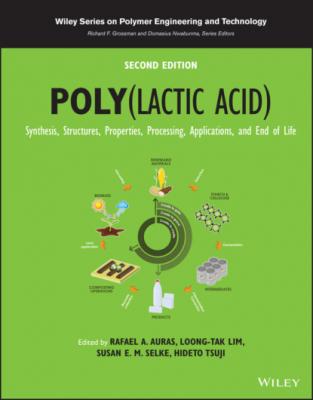Poly(lactic acid). Группа авторов
Читать онлайн.| Название | Poly(lactic acid) |
|---|---|
| Автор произведения | Группа авторов |
| Жанр | Химия |
| Серия | |
| Издательство | Химия |
| Год выпуска | 0 |
| isbn | 9781119767466 |
The effect of several different catalysts on the azeotropic dehydration of lactic acid in diphenyl ether has been studied [40]. The most effective catalysts were found to be Sn compounds (Sn powder, SnO, and SnCl2), Ni(OAc)2, and CH3─Ph─SO3H. Using these catalysts, weight‐average molecular weights exceeding 100,000 g/mol according to GPC results relative to polystyrene standards (chloroform, 40°C) were obtained for the PLA. Haloiminium salts have also been utilized as polycondensation agents in azeotropic dehydration of hydroxycarboxylic acids, including lactic acid [41].
A process to further increase the M w of the hydroxycarboxylic acid copolymerization with polyfunctional compounds was described [42]. The polyfunctional compounds were those having three or more carboxylic end groups or hydroxyl groups. In addition to this, a second compound having two or more functional end groups was present in the reaction mix. A disadvantage of the invention is that all compounds are preferably added at the same time in the beginning of the reaction, thus giving an uncontrollable reaction and therefore also reproducibility problems.
3.3 LACTIC ACID‐BASED POLYMERS BY CHAIN EXTENSION
3.3.1 Chain Extension with Diisocyanates
Chain extension with diisocyanates is undoubtedly the most commonly applied chain‐extension approach for aliphatic polyesters (Figure 3.4). A large number of different diisocyanates have been used as linking molecules in the preparation of aliphatic poly(ester‐urethane)s. Various isocyanates are listed in Table 3.1 together with the type of prepolymer used.
The most frequently used diisocyanate in the preparation of aliphatic poly(ester‐urethane)s is 1,6‐hexamethylene diisocyanate because of its low toxicity, and the use of this isocyanate will accordingly be discussed in detail. Numerous examples of the use of diisocyanate chain extension of aliphatic polyesters can be found in the scientific publications and in the patent literature [52–54].
FIGURE 3.4 Chain‐extension reactions of LA‐based prepolymers using diisocyanates.
TABLE 3.1 Diisocyanates Used in the Preparation of Aliphatic Poly(ester‐urethane)s
| Name | Prepolymer Composition | Reference |
|---|---|---|
| 1,6‐Hexamethylene diisocyanate | l‐LA, 1,4‐butanediol | [43] |
| 1,4‐Butanediisocyanate | ɛ‐caprolactone (CL), 1,4‐butanediol | [44] |
| 1,6‐Hexamethylene diisocyanate | 1,3‐propanediol, succinic acid | [45] |
| 1,4‐Butanediisocyanate | PLA, 1,4‐butanediol | [46] |
| Methylenediphenyl diisocyanate | LA | [47] |
| 4,4′‐Dicyclohexylmethane diisocyanate | l‐LA, 1,4‐butanediol | [48] |
| Isophorone diisocyanate | l‐LA, 1,4‐butanediol | [48] |
| Ethyl 2,6‐diisocyanohexanoate | CL, glycolide, inositol | [49] |
| 1,6‐Hexamethylene diisocyanate | l‐LA, mandelic acid | [50] |
| 1,6‐Hexamethylene diisocyanate | l‐LA, malic acid | [50] |
| Methylene diphenyl isocyanate | l‐LA, butyl glycidyl ether | [51] |
3.3.1.1 Chain‐Extension Reaction Parameters
The amount of diisocyanate determines to a large extent how the linking reaction proceeds. For a hydroxyl‐terminated prepolymer and an equimolar amount of diisocyanate, the chain‐extension reaction proceeds rapidly and the molecular weight reaches its maximum in a few minutes, after which the molecular weight starts to decrease due to thermal degradation [55]. Side reactions become more evident if the amount of diisocyanate is increased, which can be seen from an increase in weight‐average molecular weight but not in the number‐average molecular weight. This is caused by the formation of isocyanate‐terminated prepolymers in excess of chain extender and the further reaction with urethane bonds yielding allophanates, branching, and eventually cross‐linking. The terminal groups of the prepolymers are also important for the progress of the chain extension. Carboxylic acid end groups can react with isocyanates and yield amides, carboxylic anhydrides, or ureas even if the reactivity with hydroxyl groups is significantly higher than with carboxylic acid groups. The presence of carboxylic acid end groups has furthermore been suggested to retard the reaction between hydroxyls and isocyanates [56]. The acid number of the prepolymers is consequently an important parameter and useful as a tool for controlling the chain‐extension reaction [55, 57]. Molecular weight, molecular weight distribution, and long‐chain branching can be varied by changing reaction conditions and acid number of the prepolymer. This gives a possibility for tailoring the viscoelastic properties of the polymer and tailoring LA‐based polymers for specific processing equipment and conditions [57]. The third important parameter in the linking process is the catalyst, which will affect not only the reaction rate, but also the racemization. The racemization, that is, degree of lost tacticity, determines the ability of the poly(ester‐urethane) to crystallize, which in turn will affect the mechanical and thermomechanical properties of the polymer. It can be concluded that the preparation of poly(ester‐urethane)s can be best controlled by the following: (i) the presence of more than one type of end groups in the prepolymer being as low as possible; (ii) the semicrystalline nature being retained during both the prepolymer preparation and the linking steps; (iii) keeping the molecular weight of the prepolymer below a certain level to perform successful linking; and (d) using a catalyst that preferably is also nontoxic, with retained activity in both reaction steps [58].
3.3.1.2 Properties of Poly(Ester‐Urethane)s
The thermal and mechanical properties of poly(ester‐urethane)s are similar to those of polylactide prepared by ring‐opening polymerization, but most of the poly(ester‐urethane)s described in the literature are amorphous, with a few exceptions [58]. This means that some of the properties need to be improved to make useful end products. For many applications, the brittleness is an issue and for others the low heat resistance. Different approaches have been suggested for reducing the brittleness of PLA, for example, by copolymerization [59], blending [60], or adding plasticizing compounds [61].
The copolymerization approach has successfully been applied for poly(ester‐urethane)s by equipping the prepolymers with elastomeric properties by copolymerization. CL–LA copolymers have been
